Give yourself a helping hand to get more yard work done in less time, without wearing yourself out.
BobVila.com and its partners may earn a commission if you purchase a product through one of our links.
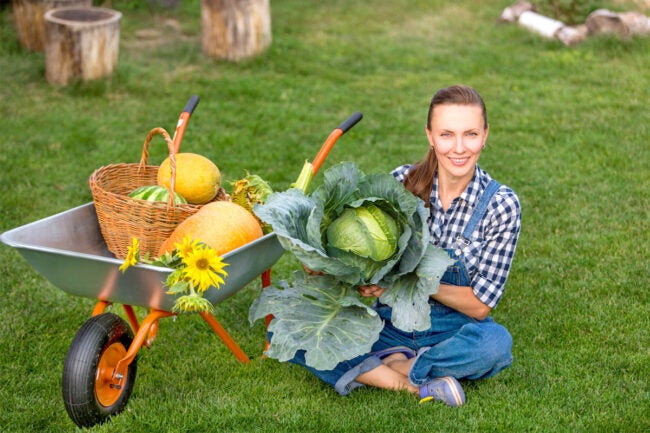
Photo: depositphotos.com
A garden cart is a straight-sided vehicle with two or more wheels that is used to tote garden tools and such supplies as earth, stones, and plants. Many gardeners prefer a spacious, stable garden cart to a wheelbarrow, with its tall, sloping sides, relatively scant floor space, and single wheel that offers lots of maneuverability but less stability than multiple wheels provide.
The best garden carts have a low center of gravity and a flat bottom for greater stability. Quality models will be maneuverable over bumpy, sloping ground and offer plenty of volume and carrying capacity to hold heavy, bulky tools and supplies. A cart’s construction and materials must be durable to withstand the elements and occasional garden mishaps. If it seems that such a versatile, dependable vehicle could be of use on your property, read on to learn about the various types of garden carts, what features to look for, and why the following are among the best available.
- BEST OVERALL: Gorilla Carts GOR800-COM Steel Utility Cart
- BEST BANG FOR THE BUCK: WORX Aerocart 8-in-1 Wheelbarrow / Yard Cart / Dolly
- BEST UTILITY: Polar Trailer #8376 Utility Cart
- BEST FOLDABLE: Tipke 2100 Marine Fold-It Utility Cart
- BEST ELECTRIC: Landworks Utility Cart
- BEST HAND TROLLEY: Harper Trucks 700 lb Capacity Convertible Hand Truck
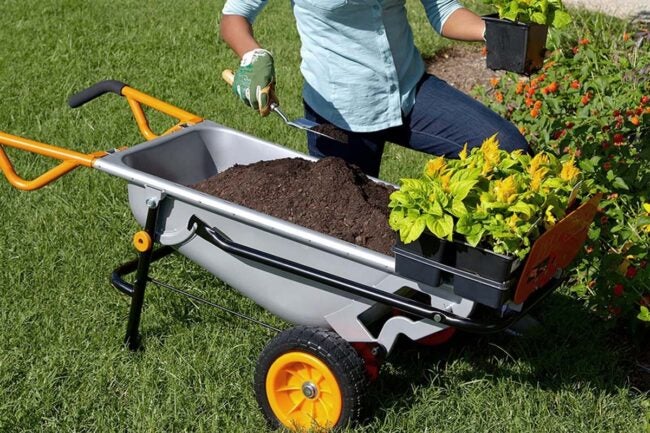
Photo: amazon.com
What to Consider When Buying the Best Garden Cart
When shopping for a garden cart, look for durable materials such as a heavy-gauge steel frame, pneumatic tires, and ultraviolet-protected plastic. Also, consider how much weight a cart can carry. Ahead, learn about the various shopping considerations that were used to assemble our picks.
Material
Light-duty carts are made entirely of plastic and are designed to carry up to 200 pounds across fairly smooth terrain. Because many plastics are susceptible to damage from temperature extremes and long-term ultraviolet sunlight exposure, carts made of this material should be stored indoors when not in use.
The strongest carts are made with steel frames and rubber tires. These materials perform well in all types of weather but do require some maintenance. Clean and repaint scratches to avoid rust. Grease the wheels, and keep tires properly inflated for best performance.
Steel-framed carts are matched with either metal or polycarbonate beds. Both materials are strong and durable, but the poly material is lighter in weight, resists dents and scratches, and is UV protected.
Capacity
Light-duty garden carts have weight capacities of 200 pounds or less. These carts are most suitable for hauling limited quantities of soil, mulch, plants, and/or garden tools. Heavy-duty carts with capacities of 350 to 500 pounds are a good choice for hauling rocks, bricks, and bags of concrete. Two-wheeled hand trucks with a weight capacity of 750 pounds or more are best for positioning large trees and landscape boulders.
Wagon vs. Cart vs. Trolley
Traditionally, a wagon had four wheels and a single handle at the front and was pulled. A cart had two wheels and one or two handles, either at the front or at the rear; depending on the design, it was either pushed or pulled. In the U.S., trolley referred to a streetcar, but in other countries, a trolley could be either a small wagon or a cart. Although there were differences among the word origins, American gardeners and tool makers now use the terms wagon and cart somewhat interchangeably. In this guide, both two- and four-wheel devices are referred to as carts.
Handle
The handle, whether on a wagon, pull cart, pushcart, or hand truck, should be comfortable and functional. For long days working in the garden, a thick handle with a cushioned grip is helpful. A 1.25- to 1.5-inch-diameter handle is about the right thickness for most gardeners to maximize grip and control and minimize hand fatigue. A rubberized grip adds traction and cushion for control and comfort.
The handle position should be high enough to push or pull comfortably. Users should not have to operate the cart while bent over or lifting extra high on the handles, nor should the user be at risk of kicking the cart while operating. When the cart is not in motion, the handle should rest in a safe position. As an example, some four-wheeled wagons feature handles with a bent shaft so it can rest in an upright position against the front of the wagon when not in use. Straight shafted handles easily fall down and can create a tripping hazard.
Tire Type and Number
Garden cart tires may be pneumatic, flat-free, or plastic.
- Pneumatic (i.e., inflatable) tires give a cushioned ride over uneven terrain. The smooth ride and large diameter make it easier to push or pull heavy loads through the landscape.
- Flat-free tires appear similar to pneumatic tires, but they are made of solid rubber. The benefit is that they never puncture or get soft, but the ride is not as smooth. They are useful in situations and terrain similar to the ones pneumatic tires are useful in.
- Plastic wheels are used on light-duty garden carts and work best on paved surfaces and smooth lawns. Like flat-free tires, they are convenient and low maintenance, but plastic is subject to cracking and warping in extreme temperatures.
Garden carts vary in terms of the number of wheels, too, ranging from two to four.
- Two-wheel carts offer easy steering, whether pulled or pushed, because they can pivot without moving forward or backward.
- Four-wheel carts are less articulate but more stable than two-wheelers. Four-wheel pull carts have a fixed axle in the rear and a steering axle in the front, connected to the pull handle. Four-wheel pushcarts use two independent swivel wheels instead of a steering axle.
- Three-wheel carts are electric. They have a powered drive axle for the two front wheels and a rear swivel wheel centered near the back to allow for steering. They have steering ability and stability comparable to four-wheelers.
Manual vs. Electric
Most garden carts are manually operated—users push or pull them wherever they need to go. But electric carts are becoming more popular as an assist for heavy projects, and for gardeners with less strength or stamina, as they absorb much of the pushing and/or pulling while the user steers. The electric motor drives the wheels and, in some cases, raises the dump bed.
Electric carts use rechargeable batteries to power their motors. Run time per charge averages about three hours, which is enough for most users to work all day. Electric carts vary in travel speeds and performance on difficult terrain. They may or may not include a braking system.
Motor
Electric carts and motor-assisted wheelbarrows can be a big help for gardeners with limited mobility, strength, and/or stamina. They utilize rechargeable batteries that mostly offer about three hours of run-time per charge, depending on the weight of the load and the slope of the terrain. Sealed lead acid (SLA) and lithium-ion are commonly available battery types, both offering fast recharge times, long run times, and full power throughout the life of the charge.
Versatility
Versatility is an important consideration because while you might purchase a garden cart for a specific upcoming project, you may wish to use it for other things in the future. Hauling soil or mulch requires bulk volume, while moving a large tree may call for greater mobility or precision movement.
A cart’s versatility is often equal to its capability. A cart that can go over rough terrain (pneumatic tires), with a heavier load (steel frame), and unload easily (dump cart) is more versatile than a cart without these features.
Types of Garden Carts
Garden carts come in different shapes and sizes, with each type suited to a particular kind of work. Below are descriptions of six basic types of garden carts and the tasks for which they are best suited.
Utility Wagon
A utility wagon is a general-purpose heavy-duty garden cart. Use it to haul anything from tools and plants to bricks, soil, and garden debris. Utility wagons may operate manually, include an electric motor, or attach to a riding lawn mower. They may have a fixed bed and sides, or include a dump bed that tilts to empty its contents, or feature removable sides to convert into a flatbed for oversize loads.
Dump Carts
Dump carts are four-wheel carts with hinged beds that tilt independently of the frame, like a dump truck. They are designed to make it easier to unload large quantities of bulk material like soil, leaves, weeds, and garden debris. Smooth plastic dump beds empty cleanly, without snagging on branches or other fine material. Metal mesh dump beds work well for larger items like rocks or firewood.
Flatbed Carts
Flatbed carts are basically flat platforms on wheels, though some convertible utility carts have side panels that may be removed to function as flatbeds. Flatbeds are easy to remove when loaded with bagged soil and mulch, or trays of plants, because such supplies slide on and off without the need for working around obstacles. Flatbeds also allow the user to load oversize items like lumber or fence posts.
Foldable Carts
Foldable carts are helpful for those who only need a cart occasionally or those with little storage space, because when not in use, they conveniently store away in small spaces. Like other quality garden carts, the best foldable models are made of tough, lightweight materials.
Electric Carts
Electric carts are self-propelled, walk-behind carts with power, forward/reverse, and speed controls located on the handgrip. They provide added power to move heavier loads. Some include powered or manual dump beds. The electric motor runs on rechargeable batteries that last between 45 minutes and three hours per charge.
Hand Trolley
A hand trolley, or hand truck, is an upright two-wheel cart that is used for heavy loads and precise placement. Some include a secondary set of wheels or casters on the back that help move bulky items across paved surfaces. Gardeners tend to use a hand trolley to move large trees or landscape boulders into place. Hand trolleys are also useful in the garage or workshop for moving large crates and appliances.
Our Top Picks
There are dozens of garden carts, including a wide range of designs. Measuring them against the above shopping considerations, outlined above, the picks below represent some of the best garden carts in various categories.
Best Overall
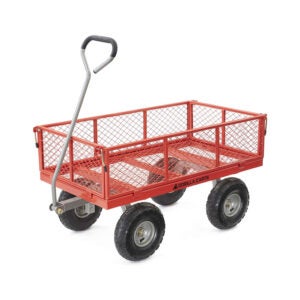
If you’ve got to haul oversize loads like lumber, bagged soils, flats of plants, and bales of straw, the Gorilla Carts Steel Utility Cart might fill the bill. The 38-by-21-inch reinforced steel-mesh bed provides strong support for heavy loads and allows moisture to drain freely away from loaded material. Its four wheels have 10-inch pneumatic tires to roll smoothly over rough terrain. The bent-shaft handle with padded handgrip allows for comfortable grip and control.
Need to move oversize loads like lumber or easily stack bagged materials like mulch or soil? The flatbed cart’s 9-inch-high steel-mesh sides go on and off easily without tools, using a simple and secure latch system to make such tasks easier.
Best Bang for the Buck
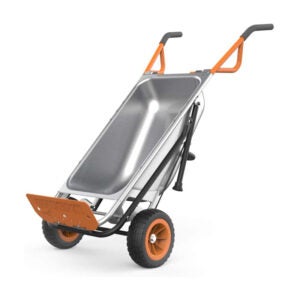
The WORX Aerocart 8-in-1 Wheelbarrow / Yard Cart / Dolly changes easily to eight different hauling configurations: wheelbarrow, dolly, long-arm dolly, cylinder mover, leaf-bag holder, rock/plant mover, trailer tote, or yard cart. Its Turbo Lift design allows the user to move the position of the axle for ideal leverage. Hauling weight capacity is 300 pounds, and the two 10-inch, flat-free tires provide increased stability over rough ground.
This multiuse cart comes at a value price, comparable to competitors that do far less. The kit includes the leaf-bag holder attachment, extended dolly arms, cylinder carrier attachment, rock sling, and plant carrier strap. (A wheelbarrow-to-wagon conversion kit, and snowplow attachment, are sold separately.)
The cart may be versatile enough to do the work of a variety of hand vehicles, and it requires less storage space than a wheelbarrow alone. Its 300-pound capacity makes it a light- to medium-duty cart, and when positioned as a wheelbarrow, it is most suitable for users shorter than 5 feet 8 inches.
Best Utility
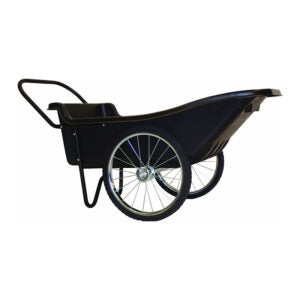
For hauling and dumping, the Polar Trailer #8376 Utility Cart is a rugged general-purpose yard cart. Its high-impact polyethylene tub, which won’t rust, crack, or warp, is suitable for gravel, firewood, and other tough materials, as well as your garden supplies, tools, and debris. The centered and balanced axle makes it easy to move and dump heavy loads, plus it dumps cleanly and won’t snag while emptying branches and other yard debris.
This two-wheeled cart features high-spoked wheels that easily traverse rough ground, and its solid rubber tires won’t go flat. The cart itself is relatively lightweight at 49 pounds, and two-wheel construction makes it highly maneuverable. A 400-pound capacity and 10-cubic-foot volume make it a medium-duty cart.
Best Foldable
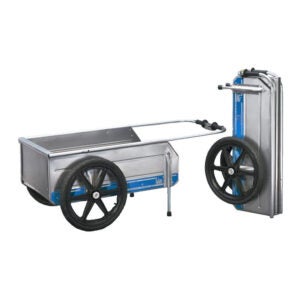
If storage space for a garden cart is tight, a foldable model like this one—which occupies less than 2 square feet when folded—might fit right in. Though the Tipke 2100 Marine Fold-It Utility Cart was specifically designed to haul gear on and off of boats in marine environments, it can serve equally well as a lightweight, durable garden cart. It offers ample carrying capacity, holding up to 330 pounds with a cargo volume of 5.75 cubic feet.
This cart balances the load directly over its two wheels for easy maneuverability. Sturdy, 20-inch pneumatic tires move easily over rough ground. A removable front panel makes loading and unloading a snap while keeping the load secure. Marine-grade aluminum construction greatly reduces the risk of rust and corrosion while also cleaning up easy for storage.
Best Electric
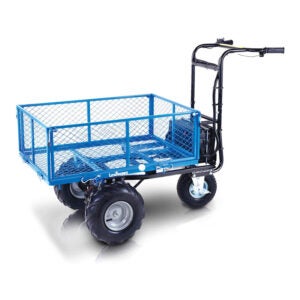
To handle heavy loads with ease, this Landworks Utility Cart employs a 48V brushless electric motor system and uses four 12V rechargeable sealed lead acid (SLA) batteries. Run time is two to five hours per charge, based on load and slope (an LED battery charge indicator lets you know when it’s time to recharge).
With a 6-cubic-foot volume, it can haul loads up to 1,000 pounds on a maximum 15-degree upward slope. The maximum forward speed is 3.1 miles per hour; reverse speed is up to 2.2 m.p.h. The cart, controlled with a simple on/off switch, has a variable-speed forward and reverse selector on the handle. The three wheels have 13-inch all-terrain pneumatic tires for excellent traction.
The steel frame and detachable steel-mesh sides are powder coated for long-lasting rust protection. The sides of the bed can be removed for flatbed use to haul oversize items like lumber or large tree limbs. The dump bed latch and handle operates with one hand by pushing down the latch release and lifting the handle.
Best Hand Trolley
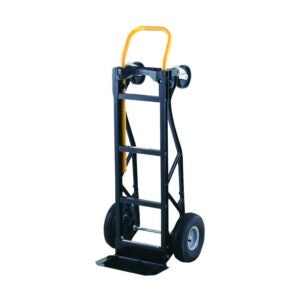
For hauling in the garden, the garage, and otherwise around your property, check out the Harper Trucks Convertible Hand Truck. This versatile model can operate as an upright dolly for hauling heavy containerized trees and appliances up to 600 pounds, and it converts to a four-wheel cart with a 700-pound capacity for carrying firewood and bags of mulch.
The nylon truss frame has the strength of a steel hand truck but is 30 percent lighter at only 28 pounds. The three-position telescoping handle and built-in stair glides allow for ease of movement up or down stairs and curbs. Heavy-duty, 10-inch pneumatic tires and 5-inch swivel casters provide excellent maneuverability.
The Advantages of Owning a Garden Cart
Although helpful for making several drop-offs around the yard, a garden cart is handy for more than hauling tools and supplies. It can function as a mobile gardening workstation, holding large and small tools and even a trash can, if you like. It conveniently carries garden supplies and equipment to the project site and hauls debris away.
Garden carts have a low center of gravity for stability that resists tipping while loaded. The cart is a convenient place to temporarily load soil while digging planting holes rather than covering up the grass or staining the sidewalk. The low stance makes it convenient to load and unload heavy items like bagged soils, landscape boulders, or large trees. A garden cart can help with just about any yard work.
- A garden cart lets you keep gardening tools and supplies with you as you move around the yard.
- A garden cart lets you haul loads of between 200 and 1,200 pounds or more.
- A garden cart can help those with limited strength, mobility, or stamina continue doing yard work.
FAQs About Your New Garden Cart
If you still have questions about purchasing a new garden cart, read on for answers to some commonly asked questions.
Q. What is a garden cart?
A garden cart is a two- or four-wheel cart that gardeners use to carry tools and supplies around the yard.
Q. What is the difference between a wheelbarrow and a garden cart?
A wheelbarrow is shaped like a half-barrel with one or two wheels in the front and two straight handles in the back. Its shape, with high sloping sides and a small tilted bottom, is best suited for hauling and dumping bulk material. A garden cart typically has between two and four wheels and a low center of gravity. Garden carts often have low, vertical sides and wide flat bottoms. They are used for all types of hauling, from tools and equipment to bagged soils, plants, and more.
Q. Do I need a garden cart?
Gardeners often find their garden cart to be more useful than their wheelbarrow. There are various types of garden carts that are suited to different kinds of hauling, including some that are motorized.
tinyurlis.gdv.gdv.htu.nuclck.ruulvis.netshrtco.detny.im
مقالات مشابه
- صندلی خلبانی سیستم سخنگو
- CDC می خواهد به می دانم که اگر برخی از ملوانان در زده حامل توسعه Coronavirus ایمنی
- شرکت صادرات و واردات کالاهای مختلف از جمله کاشی و سرامیک و ارائه دهنده خدمات ترانزیت و بارگیری دریایی و ریلی و ترخیص کالا برای کشورهای مختلف از جمله روسیه و کشورهای حوزه cis و سایر نقاط جهان - بازرگانی علی قانعی
- بهترین مارک دستگاه تولید لیوان کاغذی + لیست قیمت 1401
- باربری آیت الله کاشانی|اتوبار ارزان غرب تهران
- شرکت صادرات و واردات کالاهای مختلف از جمله کاشی و سرامیک و ارائه دهنده خدمات ترانزیت و بارگیری دریایی و ریلی و ترخیص کالا برای کشورهای مختلف از جمله روسیه و کشورهای حوزه cis و سایر نقاط جهان - بازرگانی علی قانعی
- شرکت صادرات و واردات کالاهای مختلف از جمله کاشی و سرامیک و ارائه دهنده خدمات ترانزیت و بارگیری دریایی و ریلی و ترخیص کالا برای کشورهای مختلف از جمله روسیه و کشورهای حوزه cis و سایر نقاط جهان - بازرگانی علی قانعی
- 4 روش برای سادهسازی اسباب بازی
- نمرات از رهبران نظامی بازنشسته علنا محکوم تهمت
- چه چیزی کربن فعال را حذف می کند؟